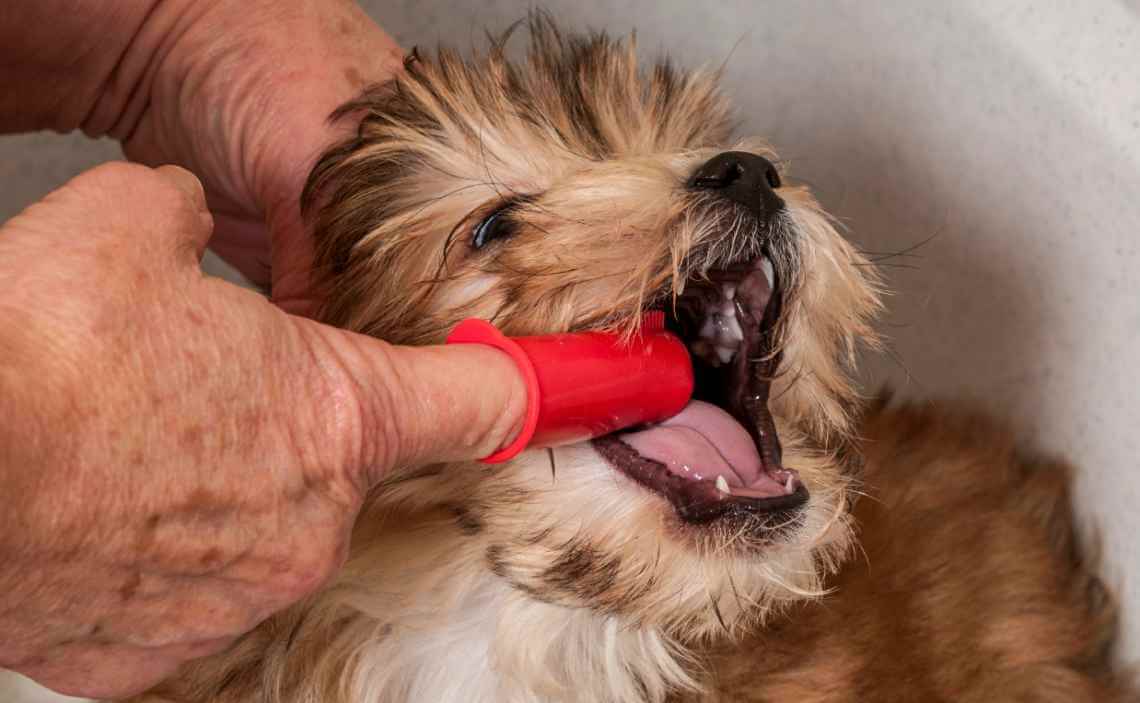
February is National Pet Dental Health month, a good time to highlight how important oral health is to the overall health, happiness and well being of your dog. It is estimated that only 2 percent of dog parents brush their teeth daily despite recommendations by veterinarians to do so.
Why is Canine Dental Health So Important?
Effective dental care is as important for dogs as it is for humans. Neglecting oral hygiene in dogs can lead to issues like tartar build up, gum disease, bad breath and even larger health problems like heart, lung and kidney disease.
Read more: Does Your Dog Have Hidden Dental Disease?

How to Brush Your Dog’s Teeth
Step #1. Set a routine
Find a time when your dog is relaxed and calm. Try to do it at the same time every day. If you can’t brush your dog’s teeth on a daily basis, even three times a week can make a difference.
Step #2. Gather your tooth brushing implements
You’ll need a toothbrush made for dogs. Dog toothbrushes have softer bristles and are angled specially for the canine mouth. Finger brushes work well for dogs under 30 pounds. For larger dogs, a handled toothbrush will give you a better reach.
Be sure to use dog toothpaste. It comes in dog-friendly flavors like poultry or peanut butter. Never use toothbrush designed for people; it contains ingredients harmful to dogs’ stomachs.

Step #3. Gain your dog’s trust
Approach your dog gently. Don’t stand over your dog, try to hold your dog down or take a threatening stance. Instead, get down on your dog’s level and sit in a relaxed position next to your dog.
Test your dog’s willingness to have you touch his or her mouth by rubbing the gums. This will help your dog get used to having you touch his or her mouth. You may need to do this a few times before he or she is ready for you to start using a brush.
While you are getting your dog used to having you touch his or her mouth, try to find a toothpaste flavor he or she likes. The idea is for your dog to think of the toothpaste as a treat.

Step #4. Start brushing
Once your dog is used to you touching his or her mouth, you can start using the toothbrush and toothpaste. Life the upper lip and angle the brush so you reach the gumline. Place the brush at a 45-degree angle so it feels more like a massage and clears away the plaque.
Use a circular motion, making sure to clean the top and bottom of each side. You may notice some bleeding occur. Light bleeding is normal, but ongoing or heavy bleeding may mean you’re brushing too hard or it may be a sign of gum disease. Speak with your veterinarian for advice.
Brush a few teeth at a time. Try to brush for two minutes total. If your dog resists, start on the outsides of the canine and back teeth, where plaque tends to collect. If you can get the insides, great. But if your dog won’t let you, don’t stress about it. Your dog’s coarse tongue keeps that area cleaner.

Step #5. Be reassuring
Keep the mood light and keep reassuring your dog during the brushing session. Tell your dog exactly what you’re doing. Remind your dog what a good pup he or she is by patting her head or stroking her jowls.
End on a positive note. Reward your dog with a treat or extra attention. Always stop when things are still fun, before your dog gets upset.
Remember that good dental care is more than brushing. There are chews and treats that can help fight plaque buildup.
Schedule regular professional dental cleanings. Talk with your vet about how often you should be taking your dog to an animal dentist.
Do you brush your dog’s teeth regularly? What tips do you have for the rest of the Canine Campus community?

 What Can Dogs Drink Besides Water? Exploring Safe and Healthy Alternatives
What Can Dogs Drink Besides Water? Exploring Safe and Healthy Alternatives Pancreatitis in Dogs – Symptoms, Causes and Treatment
Pancreatitis in Dogs – Symptoms, Causes and Treatment Understanding Lymphoma in Dogs: Symptoms, Diagnosis, and Treatment
Understanding Lymphoma in Dogs: Symptoms, Diagnosis, and Treatment Dog Friendly Cleaning Solutions
Dog Friendly Cleaning Solutions What Should Your Dog’s Poop Look Like?
What Should Your Dog’s Poop Look Like?






Leave a Reply